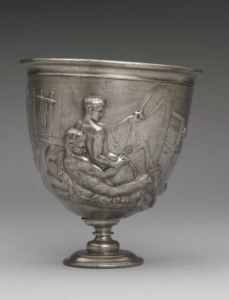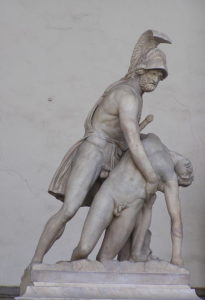In honour of LGBTQIA+ history month, Ancient History alumni Ollie Burns takes a closer look at the social, political, and cultural implications of homosexuality in ancient Rome.
Trigger Warning: sexual violence, homophobia, paedophilia, nudity.
The presentation and perception of homosexuality in the Roman world was vastly different than how it is today, and gives us an example of how homosexuality has been indelibly linked with communications of power and authority in antiquity. The Latin language has no word for either heterosexual or homosexual, and instead partners in a sexual relationship would be presented as either active, synonymous with masculinity, or passive and therefore, feminine, regardless of the gender of the individuals involved. Freeborn male Romans had the civil liberty to do as they pleased when it came to sexual activity, and as such, the concept of a Roman man engaging in homosexual sex was in no way controversial or taboo to the Romans, as long as it fell within certain parameters.

Rome was a deeply militarised state, with conquest and dominance deeply ingrained as desirable masculine traits. As a result of this, men were free to engage in homosexual relationships, so long as they were the active partner with the penetrative power, and the submissive partner was considered to be lower in society than them. For example, a free Roman man would not be subject to any form of discrimination if he engaged in sexual activity with a male slave, former slave, prostitute, or actor, but coitus with another man of the same social class would be taboo, as the act of being penetrated as a male was seen to encroach on a man’s integrity and compromised his status. Young men specifically between the ages of 12 and 20 were seen as perfectly acceptable sexual partners for a Roman man, and to an extent, there was a cultural expectation for older Romans to seek these kinds of relationships. However, free Roman boys and young men were strictly off-limits. Essentially, class and status as markers of social difference were far more important factors in determining the viability of a sexual partner than was gender.
Sex between men transcended all social

classes, and during the Imperial period, we see numerous reports of Roman emperors engaging in such relationships, the most famous being the relationship between Emperor Hadrian (r. 117 – 138) and the Greek youth, Antinous. Hadrian met the 13 year old Antinous while on a tour of the provinces in 123, and while the specificities of their relationship are largely unknown, the two are believed to have engaged in a pederastic relationship until Antinous’ death at the age of 20, when he drowned in the Nile. Hadrian was so affected by this that he had Antinous deified, and a cult dedicated to his worship spread across the empire. Despite Hadrian’s obvious devotion however, Antinous’ early demise has led to speculation that his death was not accidental, and that he was purposefully killed. He was approaching an age which would render him too old for his relationship with the Emperor to be socially appropriate, which, if true, demonstrates the strict fixedness of the parameters around which homosexual relations were permitted among Roman men. As well as Hadrian, we hear of Emperor Titus keeping a great number of male concubines, and that Nero married a young man, whom he then had castrated to preserve his youthful qualities.
The act of penetrative sex between males was inexplicably linked with the active man’s dominance and prowess, and it was regarded as scandalous and humiliating for men to be the passive partner. Julius Caesar was accused by political opponents in the late 50s/early 40s BC to have engaged in a sexual relationship with King Nicomedes IV of Bithynia when he had been a guest at the Bithynian court in 80 BC. While it is unclear as to whether this claim is true, Caesar was rumoured to have been the passive sexual partner, earning him the title ‘The Queen of Bithynia’ from his enemies, demonstrating the relationship between passivity and femininity, as well as the emasculatory effects that being the recipient of homosexual sex entailed. Even when Caesar returned to Rome after conquering Gaul he could not escape the rumours, and the chant ‘Caesar laid Gaul low, but Nicomedes laid Caesar low’ rang out at his triumphal procession.
In summary, homosexuality in ancient Rome was as much about communications of power and status than it was about attraction and emotion, with sex as a vehicle to exercise privilege and dominance. The civil freedoms of a Roman citizen allowed him to engage in such relations with any man lower in society than him, whilst demonstrating his virility and ability to conquer others. It translates so directly to displays of power that Roman men were even known to orally rape their rivals to express their superiority over them whilst ridiculing the victim, although laws were put in place to prosecute the offender and protect the status of the victim. The case of Caesar shows elite men were targets for slander from others for being a passive partner, and it could damage a man’s political reputation.
For more information, see Craig Williams’ ‘ Roman Homosexuality’, Saara Lijia’s ‘Homosexuality in Republican and Augustan Rome’, or Suetonius’ ‘Lives of the Caesars’.
Thanks to Ollie Burns!
